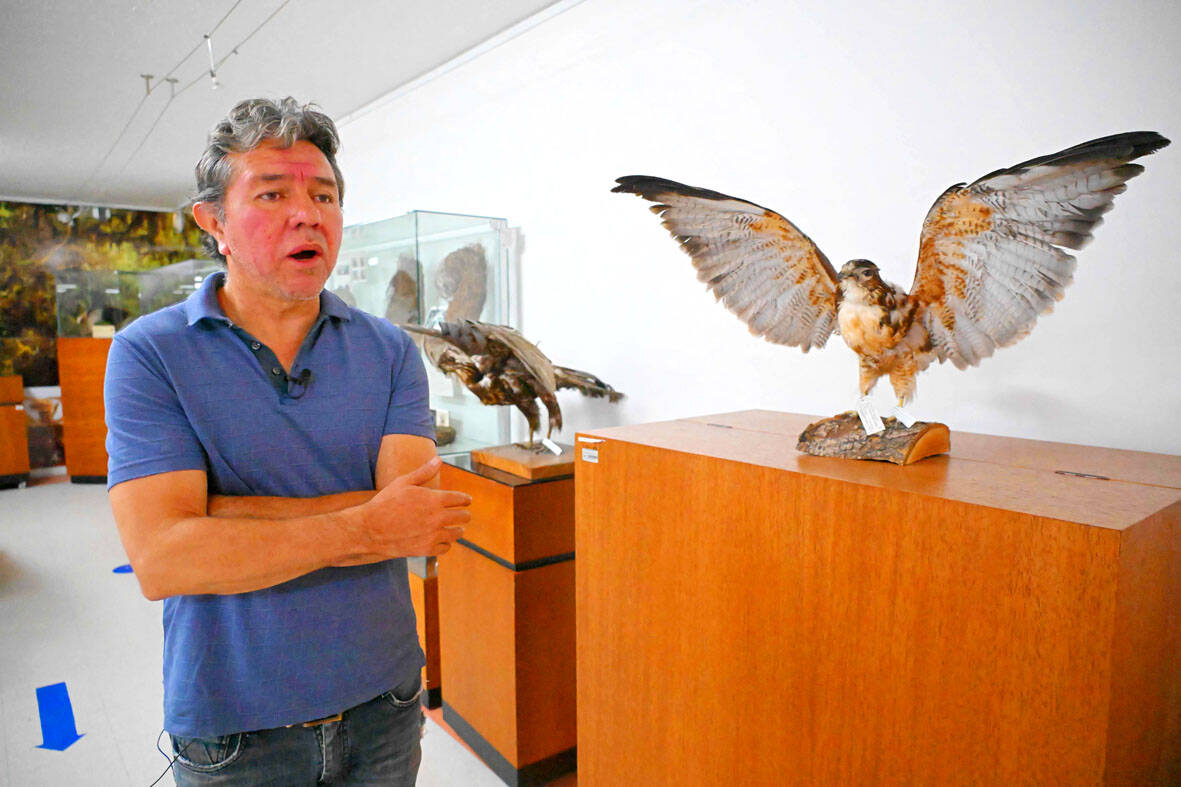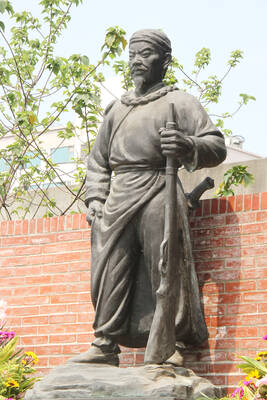Biologist Cesar Garzon was searching for a small, endangered parakeet in southern Ecuador when he was warned he may be kidnapped, highlighting the danger for scientists in the biodiverse country engulfed in narco-violence.
“Do your work somewhere else because it is dangerous here,” he said a man told him in April, in the troubled mining town of Camilo Ponce Enriquez.
That night, the town’s mayor was shot dead. Earlier this month, a clash between criminal groups in the town left five dead, two of whom were found decapitated, and one burned.

Photo: AFP
Garzon, a bird expert at the state-run National Institute of Biodiversity (Inabio), tried to continue his research in a neighboring town, whose mayor was also killed.
Tired of the ever-present danger, he packed his bags and returned to Quito.
Garzon has been studying the El Oro parakeet for two decades, working for its conservation and supporting the sustainable management of its habitats.
Mostly green, with a red forehead, the bird is endemic to Ecuador and has only been seen in the country’s southwest provinces of Azuay and El Oro.
With only an estimated 1,000 specimens remaining, the International Union for Conservation of Nature (IUCN) lists it as in danger of extinction.
Garzon visited Camilo Ponce Enriquez, in Azuay province, to track down and study the endangered parakeet. But the gold-rich town is in the grips of the Los Lobos drug trafficking gang, which finances its activities with illegal mining.
“We are left with uncertainty and frustration ... There is a lack of information on that site,” he said. He said the violence was a blow to conservation as there “could be important areas that are home to endemic or threatened species and we can’t do anything.”
WINDOW OF OPPORTUNITY
Sandwiched between Colombia and Peru, the world’s top cocaine producers, once-peaceful Ecuador has seen violence explode in recent years as enemy gangs with links to Mexican and Colombian cartels vie for control.
As the gangs have gained ground, homicides in Ecuador soared from six per 100,000 inhabitants in 2018 to a record 47 per 100,000 last year.
Mario Yanez, another biologist from Inabio, said his current work revolves around finding “windows of opportunity” to continue researching despite the violence. Scientists work closely with local communities and authorities and do shorter field trips or focus on similar species located in less risky areas.
“The levels of violence have led to total restrictions in certain areas of the country,” especially on the coast and where there is mining, said Yanez.
These places carry the “stigma” of the violence and that “unfortunately is limiting international cooperation funds to be able to carry out conservation actions,” he added.
SECURITY CRISIS
The private Lalo Loor reserve in southwestern Manabi is one of Ecuador’s last intact remnants of a unique ecosystem known as a coastal dry forest, home to many endemic species.
The province is also a drug trafficking stronghold. Due to the security crisis, American universities cancelled an annual visit of researchers and students to the reserve, a major source of income for Lalo Loor.
Their continued absence could force the reserve’s administrative office to shutter, manager Mariela Loor said.
Judith Denkinger, a German biologist at the private Universidad San Francisco de Quito, said that since 2022 she has put on hold her two decades of research into humpback whales on the coast of the conflict-ridden northwestern province of Esmeraldas, bordering Colombia.
She has been unable to gather photographic or acoustic records of the humpback whales that come to the equatorial Pacific to mate and give birth.
She also highlighted the plight of fishermen — who she often works with at sea.
“Pirates, who are usually drug traffickers, come and threaten them, hijack their boat or steal their motor or kidnap them” to force them into drug trafficking, she said.
Daniel Vizuete, a specialist in Social Studies of Science and Technology at the Flacso University in Quito, said research related to the environment was “perhaps the most eroded precisely because it occurs ... in places where institutions are weaker.”
“That means that even the lives of researchers can be at risk,” he added. He also points to other possible effects of criminal violence on science such as a “setback in terms of participation of women.”

One of the biggest sore spots in Taiwan’s historical friendship with the US came in 1979 when US president Jimmy Carter broke off formal diplomatic relations with Taiwan’s Republic of China (ROC) government so that the US could establish relations with the People’s Republic of China (PRC). Taiwan’s derecognition came purely at China’s insistence, and the US took the deal. Retired American diplomat John Tkacik, who for almost decade surrounding that schism, from 1974 to 1982, worked in embassies in Taipei and Beijing and at the Taiwan Desk in Washington DC, recently argued in the Taipei Times that “President Carter’s derecognition

This year will go down in the history books. Taiwan faces enormous turmoil and uncertainty in the coming months. Which political parties are in a good position to handle big changes? All of the main parties are beset with challenges. Taking stock, this column examined the Taiwan People’s Party (TPP) (“Huang Kuo-chang’s choking the life out of the TPP,” May 28, page 12), the Democratic Progressive Party (DPP) (“Challenges amid choppy waters for the DPP,” June 14, page 12) and the Chinese Nationalist Party (KMT) (“KMT struggles to seize opportunities as ‘interesting times’ loom,” June 20, page 11). Times like these can

JUNE 30 to JULY 6 After being routed by the Japanese in the bloody battle of Baguashan (八卦山), Hsu Hsiang (徐驤) and a handful of surviving Hakka fighters sped toward Tainan. There, he would meet with Liu Yung-fu (劉永福), leader of the Black Flag Army who had assumed control of the resisting Republic of Formosa after its president and vice-president fled to China. Hsu, who had been fighting non-stop for over two months from Taoyuan to Changhua, was reportedly injured and exhausted. As the story goes, Liu advised that Hsu take shelter in China to recover and regroup, but Hsu steadfastly

You can tell a lot about a generation from the contents of their cool box: nowadays the barbecue ice bucket is likely to be filled with hard seltzers, non-alcoholic beers and fluorescent BuzzBallz — a particular favorite among Gen Z. Two decades ago, it was WKD, Bacardi Breezers and the odd Smirnoff Ice bobbing in a puddle of melted ice. And while nostalgia may have brought back some alcopops, the new wave of ready-to-drink (RTD) options look and taste noticeably different. It is not just the drinks that have changed, but drinking habits too, driven in part by more health-conscious consumers and